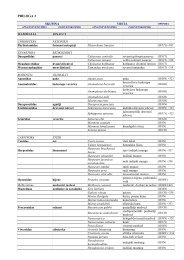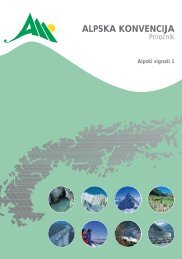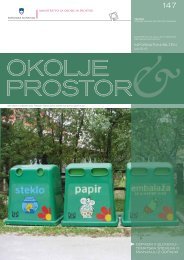Atlas of Flood Maps
Atlas of Flood Maps
Atlas of Flood Maps
Create successful ePaper yourself
Turn your PDF publications into a flip-book with our unique Google optimized e-Paper software.
EU <strong>Flood</strong> Risk <strong>Maps</strong> Q4310 September, 2007<br />
Examples from EU countries<br />
WL | Delft Hydraulics<br />
events. <strong>Maps</strong> normally cover only a certain village or community.<br />
More detailed information can be found on the internet 1 .<br />
Comments on the maps<br />
Four maps are shown as examples <strong>of</strong> flood maps in Austria for the same region (fictitious<br />
region ‘Muster’, Figure 4.2 - Figure 4.5). As a general comment the maps are very clear and<br />
especially the cadastre background <strong>of</strong> the urbanization and infrastructure make them easy to<br />
read. It may be useful for anyone not familiar to the region to have a small map added that<br />
shows the location within Austria. Another comment is that the North indication on the map<br />
is rather small and may obtain a more prominent position, especially in this case where<br />
North is not at the top <strong>of</strong> the map.<br />
In Figure 4.2 both flood extension and expected water depth are given. In fact both water<br />
depth and water level (absolute value) are given. The latter might give an indication <strong>of</strong> the<br />
flow direction, although a flood extension map is normally a representation <strong>of</strong> a static<br />
situation, not <strong>of</strong> the inundation process. For the flood extension, three standard return<br />
periods <strong>of</strong> 1/30, 1/100 and 1/300 yr are used that are the norm in Austria, but the water<br />
depth is given for the 1/100 yr flood event. The differences between the extensions<br />
corresponding to the three return periods are shown by symbols on lines instead <strong>of</strong> a system<br />
<strong>of</strong> coloured surfaces. As an alternative use can be made <strong>of</strong> an indication <strong>of</strong> altitude similar<br />
to topographic maps, either with colours and/or putting the actual value (30 – 100 – 300)<br />
within the lines.<br />
The water depths are given in an interval <strong>of</strong> 0.25 m, which is probably in line with the<br />
accuracy <strong>of</strong> the information, but the combination <strong>of</strong> colours is less common. The smallest<br />
depth (0 - 0.25 m) is shown in light blue and darker hues <strong>of</strong> blue are used for larger depths<br />
up to 1.25 m, but then a shift is made to green with increasing depth indicated by lighter<br />
hues (up to 3.00 m). Green is normally used as an indication <strong>of</strong> safety and as was explained<br />
in Chapter 3.1. Water depth is preferably indicated by hues <strong>of</strong> blue. In case there are many<br />
intervals the differences between the various shades <strong>of</strong> blue may become obliterate and it<br />
might be an option to change to a larger interval (e.g. 0.5 m) instead <strong>of</strong> using a combination<br />
<strong>of</strong> colours.<br />
Although it can be deduced from the legend that the flood extension and water depth in<br />
numbers refer to the event with a return period <strong>of</strong> 1/100 yr, this is not indicated in the<br />
subtitle <strong>of</strong> the map.<br />
In Figure 4.3 flood hazard zones are indicated using four levels <strong>of</strong> hazard (blue, orange,<br />
yellow and red). Although red is normally the highest hazard, it is not immediately clear<br />
from the map what the order <strong>of</strong> the hazards is. The colour blue is already being used for<br />
inundation depth and may be left out <strong>of</strong> the colour palette here. It is very useful in this map<br />
that the hazard zones are combined with land-use information, although the overall use <strong>of</strong><br />
the same colour for this purpose (green) does not allow for an easy distinction between<br />
various types <strong>of</strong> landuse. There is however also another map available showing these hazard<br />
zones on top <strong>of</strong> an aerial photograph.<br />
1 http://www.wassernet.at/<br />
4—2







